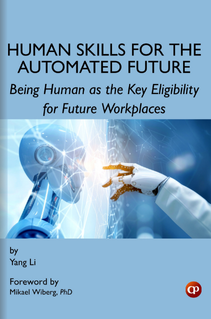Developing And Promoting Creativity

by Yang Li
Academic Researcher & K-12 Consultant, Jiangsu-Nanjing 210023, China.
10.46679/9788196780586ch04
This chapter is a part of: Human Skills for the Automated Future: Being Human as the Key Eligibility for Future Workplaces by Yang Li
ISBN (Ebook):978-81-967805-8-6
ISBN (Softcover Print):978-93-49926-23-3
© CSMFL Publications & its authors.
Published: May 15, 2025
Abstract
One of the most important tasks in today’s connected world is to be in a position to promote creativity in younger generations. The chapter explains the creative thinking concept and its elements that support it, such as imagination, divergent thinking ability, and connecting completely irrelevant things. The chapter proceeds to explain how all these elements can be integrated into the curriculum planning process. It calls for educational methods that allow students to explore and question, learn through inquiry, have choices to express themselves differently—project-based learning, open-ended problems, and a safe environment to experiment and fail.
All this would be very critical in developing creativity: empowering the student and educator. The chapter discusses how educators can increase their own creative spirit and then put that in action when designing classroom activities. This could include pursuing professional development opportunities to introduce creative activities into the classroom and continuing to develop a growth mindset themselves and their students. It is only by instilling a strong ability to creatively think in the next generation and preparing them for what AI has in store, that will lead them to develop innovation-forward solution for the world’s most intractable problems.
Keywords: Creativity, Creative Thinking, Imagination, Divergent Thinking, Curriculum Planning
References
- Yang, H. (2004). To Foster Students’ Creativity through Classroom Teaching.
- Wei-don, W. (2010). On Fostering Creative Thinking. Journal of Hubei Radio & Television University.
- Calavia, M. B., Blanco, T., & Casas, R. (2021). Fostering creativity as a problem-solving competence through design: Think-Create-Learn, a tool for teachers. Thinking Skills and Creativity, 39. https://doi.org/10.1016/j.tsc.2020.100761
- Hong, E., Hartzell, S. A., & Greene, M. T. (2009). Fostering Creativity in the Classroom: Effects of Teachers’ Epistemological Beliefs, Motivation, and Goal Orientation. The Journal of Creative Behavior, 43(3), 192–208. https://doi.org/10.1002/j.2162-6057.2009.tb01314.x
- Huang, R., Li, B., Zhang, J., Ohashi, T., Chen, Y., Ma, J., Wang, Z., Zhang, M., Yu, R., Qiu, D., Liu, Y., Zou, Z., & Liu, W. (2024). Fostering Student Creativity: A Curriculum Proposal in the Context of “Innovation and Entrepreneurship” and “Double Reduction” Policies. AHFE International. https://doi.org/10.54941/ahfe1004555
- Hunter, B. E. (1993). Fostering Creativity: Ensuring Quality in Education. NASSP Bulletin, 77(555), 104–109. https://doi.org/10.1177/019263659307755514
- Kempton, G. A. (2017). Creativity in Education: Exploring Teacher Experiences of Creativity through an Immersion Studies Learning Framework. QUT EPrints. https://doi.org/10.5204/thesis.eprints.110591
- Southall, M. (2019). Approaches to Planning that Encourage Creativity. Contemporary Issues in Technology Education, 123–138. https://doi.org/10.1007/978-981-13-3010-0_9
- Teaching Expertise. (2013, May 12). Creativity in the curriculum – Teaching Expertise. Https://Www.teachingexpertise.com/Articles/Creativity-In-The-Curriculum/; Teaching Expertise. https://www.teachingexpertise.com/articles/creativity-in-the-curriculum/
- Wooll, M. (2021, April 15). What is creative thinking and why does it matter? | BetterUp. Www.betterup.com. https://www.betterup.com/blog/creative-thinking
This book is available worldwide via EBSCOhost Academic Collection, EBSCO E- books, Google Play Books, Amazon, World Cat Discovery Service/OCLC, CSMFL Bookstore, and 200+ book resellers and academic content vendors.
Statement on Publication Ethics
We, at CSMFL Publications, are committed to ensure the unbiased and transparent publishing, and upholding the high standards of editorial integrity in our publications. To know more, please read our Statement on Publication Ethics, Editorial Integrity & Misconduct